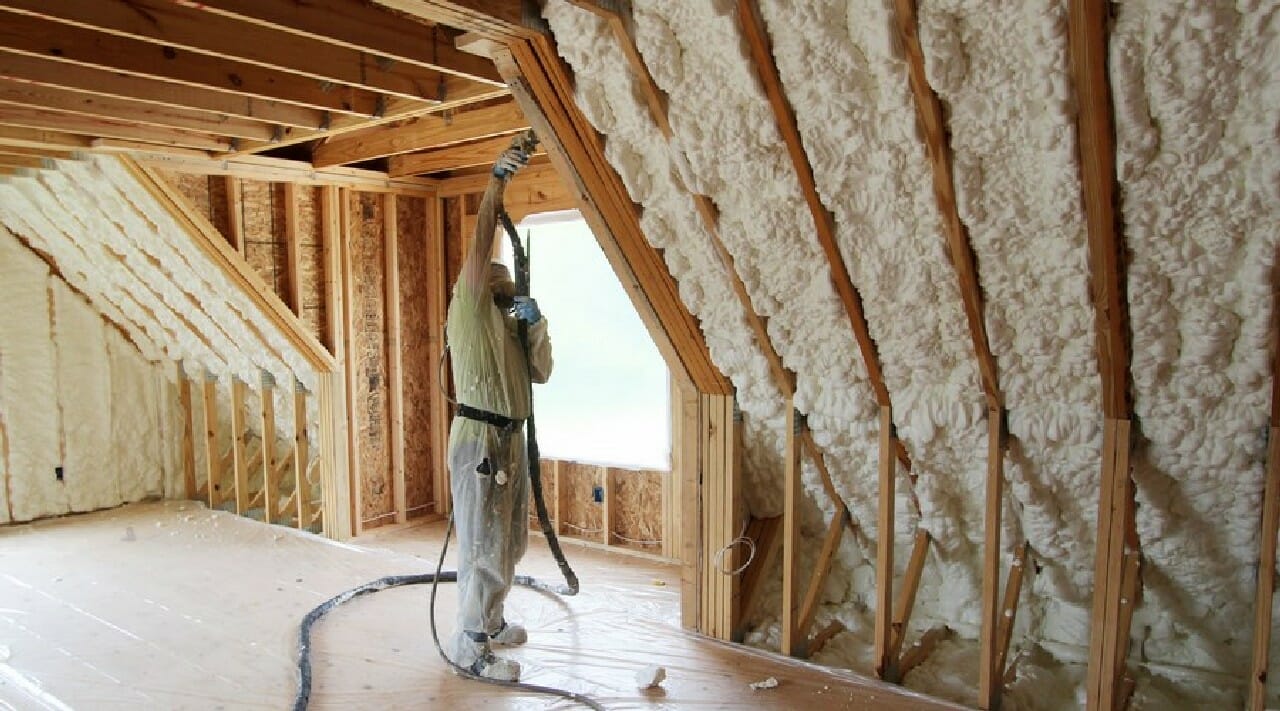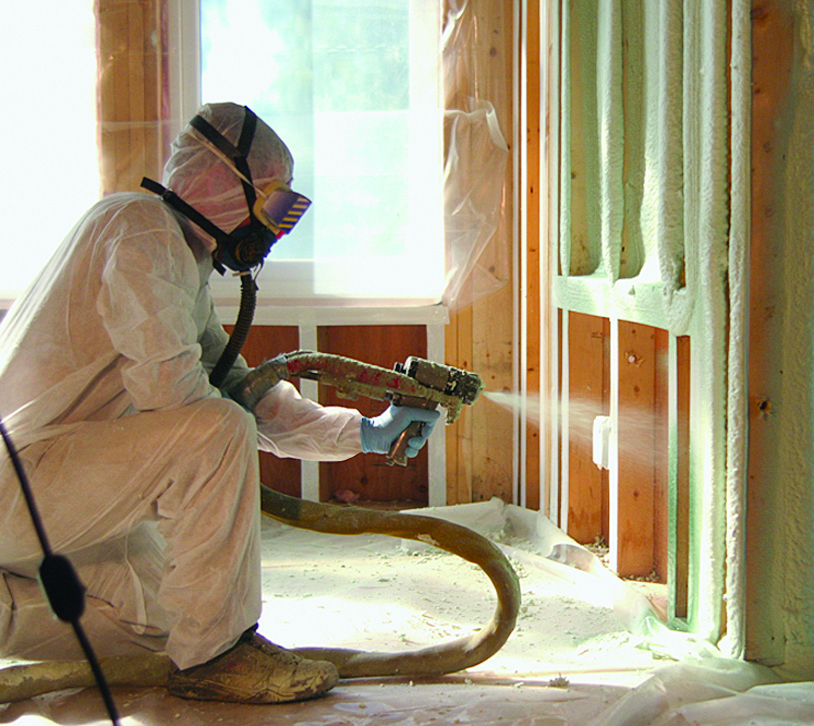Open-cell spray foam is an excellent material for creating a quieter living space. Its unique physical structure makes it one of the most effective insulation products for sound dampening. The foam’s soft, pliable consistency and its interconnected, “open” cell structure are exceptionally good at absorbing and dissipating airborne sound waves. When sound hits the foam, it gets trapped within this complex network of cells, and its energy is converted into a tiny amount of heat, which effectively deadens the noise. This makes it a top choice for reducing noise from traffic, neighbors, and within the home itself.
While many people choose insulation based on its thermal properties, the acoustic benefits can be just as important for overall home comfort. The information in this article comes from the hands-on experience of insulation professionals and building scientists who understand the physics of sound control. This article explores exactly how open-cell foam works to quiet a home, where it is most effective, and how it compares to other common insulation materials.
The Science of Sound and How Open-Cell Foam Works
To understand why open-cell spray foam insulation is so good at sound control, it’s helpful to know a little about how sound travels. There are two main types of noise that affect a home:
- Airborne Noise: This is sound that travels through the air, like conversations, television sounds, or traffic from outside.
- Structure-Borne Noise: This is sound that travels through the solid components of a building, like footsteps on the floor above or the vibration from a plumbing pipe.
Open-cell spray foam excels at controlling airborne noise. Its effectiveness comes from two key properties:
- Sound Absorption: The foam’s soft, porous texture acts like a sponge for sound waves. Instead of reflecting the sound back into the room or allowing it to pass through the wall, the foam absorbs the sound energy. This is measured by a Noise Reduction Coefficient (NRC), where a higher number means better absorption. Open-cell foam has a very high NRC.
- Air Sealing: Sound, much like air, will travel through any crack or gap it can find. When open-cell foam is sprayed into a wall cavity, it expands to fill every single void, sealing off the tiny air leaks that would otherwise allow sound to pass through. This complete air seal is something traditional batt insulation simply cannot achieve.
Where to Use Open-Cell Foam for Maximum Sound Control
Because of its sound-dampening qualities, open-cell foam is an ideal choice for specific areas of a home where peace and quiet are a priority.
- Interior Walls: This is one of the most popular applications. Installing it in the walls between bedrooms, bathrooms, a home office, or a laundry room can make a huge difference in daily life. It’s especially effective for creating a quiet media room or home theater.
- Floors Between Stories: Using open-cell foam in the floor joist cavities can significantly reduce the sound of conversations, music, and television from traveling between floors.
- Exterior Walls: While also a great thermal insulator, using open-cell foam in exterior walls helps to create a quiet sanctuary by reducing noise from traffic, lawnmowers, and neighbors. This can be particularly valuable for homes in denser neighborhoods or near busy roads. For the best results, a comprehensive strategy is needed, which includes paying attention to sound leaks through doors, windows, and ventilation ducts.
How It Compares to Other Insulation Materials
Not all insulation materials are created equal when it comes to acoustics. Some are designed for thermal performance, while others are better at absorbing sound.
| Insulation Material | Primary Acoustic Function | Typical NRC Rating | Notes |
|---|---|---|---|
| Open-Cell Spray Foam | Sound Absorption & Air Sealing | 0.70 | It is excellent for airborne noise. |
| Closed-Cell Spray Foam | Air Sealing | 0.30 | Its rigid structure reflects more sound. |
| Fiberglass Batts | Sound Absorption | 0.80 – 0.95 | It’s a good absorber but doesn’t air seal, leaving gaps for sound. |
| Blown-In Cellulose | Sound Absorption & Damping | 0.80 | It fills cavities well but can settle over time. |
While fiberglass has a high NRC in a lab setting, its real-world performance is often lower because it’s nearly impossible to install it without gaps and voids. Open-cell foam’s ability to create a perfect air seal gives it a performance edge in a finished wall.
Things to Consider Before You Insulate for Sound
- The Type of Noise: Open-cell foam is fantastic for airborne noise. For structure-borne noise, like heavy footfalls, additional measures like resilient channels or mass-loaded vinyl are often needed. To further reduce footfall noise between floors, installers can use resilient isolation clips on the ceiling joists before hanging drywall to decouple the ceiling from the floor structure. A professional can help identify the type of noise problem and recommend a complete solution.
- Budget: Open-cell spray foam typically has a higher upfront cost than fiberglass or cellulose. However, many homeowners find the investment is worth it for the combined thermal and acoustic benefits.
- Professional Installation is Key: The performance of spray foam is entirely dependent on the quality of the installation. The foam must be sprayed to the correct thickness and density to achieve its full sound-dampening potential.
Your Questions About Soundproofing with Foam Answered
Is closed-cell foam also good for soundproofing?
Not as good as open-cell. Closed-cell foam is dense and rigid. This structure is great for thermal insulation and structural strength, but it tends to reflect sound rather than absorb it. For pure sound control, open-cell is the superior choice.
Will open-cell foam completely soundproof a room?
No insulation product can make a room completely “soundproof” on its own. That requires a very specific and expensive construction assembly. However, open-cell foam can make a room significantly quieter, often reducing audible noise from adjacent rooms by 80% or more.
Does the thickness of the foam matter for sound?
Yes. Generally, a thicker application of open-cell foam will provide better sound absorption, especially for lower-frequency sounds. For a standard 2×4 wall, filling the entire 3.5-inch cavity is the standard and most effective practice.
Can open-cell foam be installed in an existing home?
Yes, but it’s more involved than in new construction. For existing walls, installers use a “drill-and-fill” method where small holes are drilled in the drywall to inject the foam. This is best suited for major renovations where walls are already being opened up for other reasons.
Are there any health concerns with open-cell foam?
Modern open-cell foams are designed to be safe once cured. During installation, the chemical reaction releases vapors, so professionals use protective gear and proper ventilation. It’s standard practice for residents to vacate the property during the application and for a recommended period afterward (usually 24 hours) to allow the foam to fully cure and air out.
A Quieter Home is a More Comfortable Home
In the quest for a comfortable home, the importance of a quiet environment cannot be overstated. Expert spray foam insulation offers a powerful, two-in-one solution that provides excellent thermal insulation and superior sound control. By absorbing airborne noise and sealing the hidden pathways that sound travels, it helps to create a more peaceful and private living space. For anyone building a new home or undertaking a major renovation, it is a smart investment in long-term comfort.
Get a Professional Acoustic Insulation Plan
Every home and every noise problem is unique. A professional insulation contractor with experience in acoustics can design a solution tailored to a specific space and budget. For those interested in exploring how advanced insulation materials can improve their living environment, the experts at High Country Solutions provide detailed consultations. They can assess a property’s needs and recommend a comprehensive strategy. For more information, they can be reached at [email protected] or by phone at (307) 248-9063.
Author: Skeeter Aimone, co-founder of High Country Solutions, is a building science specialist focused on creating healthier and more comfortable living environments. Brad Morrison leads the company’s material and application technology, ensuring high-performance results with a focus on modern insulation solutions. Established in 2018, they bring years of combined experience to improving home energy efficiency and acoustic comfort.
Reviewer: Samuel Harris has worked across various roles in spray foam insulation over 11 years. His review focused on how businesses can better present their services to both new and returning clients.

